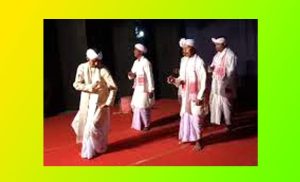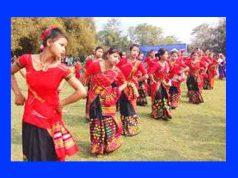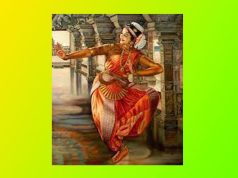ওজাপালি (Ojapali) অসমৰ এক বিশেষ পৰিবেশ্য কলা। এই কলা শৈলীৰ মূল উদ্দেশ্য হৈছে পৌৰাণিক কাহিনী আৰু ধৰ্মীয় আখ্যানসমূহক গীত, নৃত্য আৰু অভিনয়ৰ মাধ্যমেৰে জনসাধাৰণৰ মাজত প্ৰচাৰ কৰা। ওজাপালি মূলতঃ দুই প্ৰকাৰৰ হয়: বিয়াহৰ ওজাপালি (ব্যাসৰ) আৰু সুকনানি ওজাপালি।
ওজাপালি। Ojapali
ওজাপালি: অসমৰ এক বিশেষ পৰিবেশ্য কলা
ওজাপালি অসমৰ এক বিশেষ পৰিবেশ্য কলা। এই কলা শৈলীৰ মূল উদ্দেশ্য হৈছে পৌৰাণিক কাহিনী আৰু ধৰ্মীয় আখ্যানসমূহক গীত, নৃত্য আৰু অভিনয়ৰ মাধ্যমেৰে জনসাধাৰণৰ মাজত প্ৰচাৰ কৰা। ওজাপালি মূলতঃ দুই প্ৰকাৰৰ হয়: বিয়াহৰ ওজাপালি (ব্যাসৰ) আৰু সুকনানি ওজাপালি।
বিয়াহৰ ওজাপালি (ব্যাসৰ)
বিয়াহৰ ওজাপালিত ৰামায়ণ, মহাভাৰত আৰু পুৰাণৰ কাহিনীসমূহ গীত আৰু পদৰ মাধ্যমেৰে পৰিৱেশন কৰা হয়। এই অনুষ্ঠানত ওজাই মূল গায়ক আৰু পালিসকলে মঞ্জিৰ বা তাল বজাই সেই গীত দোহাৰে। এই শৈলীত নাটকীয় সংলাপ আৰু ক্ৰিয়াৰ মাজত আখ্যানমূলক গায়ন-বায়ন আৰু নৃত্যৰ সংমিশ্ৰণ ঘটে।
সুকনানি ওজাপালি
সুকনানি ওজাপালিত সুকবি নাৰায়ণদেৱৰ পদ্মপুৰাণৰ কাহিনী গীত আকাৰে গোৱা হয়। দেওধনি নৃত্য সুকনানি ওজাপালিৰ অন্তৰ্গত। এই শৈলীত গীত, নৃত্য আৰু অভিনয়ৰ মাধ্যমেৰে পদ্মপুৰাণৰ কাহিনীসমূহ জনসাধাৰণৰ মাজত প্ৰচাৰ কৰা হয়।
ওজাপালিৰ ইতিহাস
ওজাপালি কলা শৈলীৰ উদ্ভৱ প্ৰাচীন কালত। এই শৈলীৰ উদ্ভৱ আৰু বিকাশত মন্দিৰৰ প্ৰভূত অৰিহণা আছে। এক দৈৱিক মতবাদ অনুসৰি বৃহন্নলাৰূপী অৰ্জুনৰ দ্বাৰা এইবিধ কলা স্বৰ্গৰপৰা মৰ্ত্যত প্ৰচলিত হয়। পাৰিজাত নামৰ এগৰাকী মহিলাই স্বপ্নৰ দ্বাৰা এই কলা আয়ত্ব কৰি শিষ্যসকলক শিকায় বুলিও বিয়াহৰ ওজাপালিসকলে বিশ্বাস কৰে।
ওজাপালিৰ বৈশিষ্ট্য
ওজাপালিৰ পৰিৱেশনত এজন ওজা আৰু চাৰিজনৰ পৰা ছজনলৈ পালি থাকে। ওজাই ‘দিহা’ৰে আৰম্ভ কৰি কোনো এটা পৌৰাণিক কাহিনী বা আখ্যান বিভিন্ন ৰূপত গাই যায় আৰু পালিসকলে মঞ্জিৰ বা তাল বজাই সেই গীত দোহাৰে আৰু ভৰিৰে তাল ৰাখি যায়। নৃত্য-গীত-তালক লৈয়ে ওজাপালি।
ওজাপালি: প্ৰশ্ন আৰু উত্তৰ
ওজাপালি কি?
ওজাপালি হৈছে অসমৰ এক বিশেষ পৰিবেশ্য কলা, য’ত গীত, নৃত্য আৰু অভিনয়ৰ মাধ্যমেৰে পৌৰাণিক কাহিনী আৰু ধৰ্মীয় আখ্যানসমূহ জনসাধাৰণৰ মাজত প্ৰচাৰ কৰা হয়।
ওজাপালিৰ প্ৰকাৰসমূহ কি কি?
ওজাপালি মূলতঃ দুই প্ৰকাৰৰ হয়: বিয়াহৰ ওজাপালি (ব্যাসৰ) আৰু সুকনানি ওজাপালি।
ওজাপালিৰ ইতিহাস কি?
ওজাপালি কলা শৈলীৰ উদ্ভৱ প্ৰাচীন কালৰেপৰা। এই কলা শৈলীৰ উদ্ভৱ আৰু বিকাশত মন্দিৰৰ প্ৰভূত অৰিহণা আছে।
ওজাপালিত কিমানজন শিল্পী থাকে?
ওজাপালিৰ পৰিৱেশনত এজন ওজা আৰু চাৰিজনৰ পৰা ছজনলৈ পালি থাকে।
ওজাপালি: তথ্য
- উদ্ভৱ স্থান: অসম
- প্ৰধান উপাদান: গীত, নৃত্য, অভিনয়
- প্ৰধান কাহিনী: ৰামায়ণ, মহাভাৰত, পদ্মপুৰাণ
- প্ৰধান শিল্পী: ওজা, পালি
.
Ojapali: A Unique Art Form of Assam
Ojapali is a traditional art form of Assam that has deep cultural roots and is cherished for its unique blend of music, dance, and storytelling. This ancient form of performance has been a part of Assam’s cultural landscape for centuries and continues to be an important aspect of the state’s artistic heritage.
Types of Ojapali
Ojapali is divided into two distinct types based on the content and nature of the performance: ‘Byash Ojapali (also known as Biyahar Ojapali)’ and ‘Sukanani Ojapali’. Each type has its own significance and is performed during different occasions, with variations in the themes and style of presentation.
Byash Ojapali (Biyahar Ojapali)
Byash Ojapali is primarily performed during weddings and other joyous occasions. The performances in Byash Ojapali are often centered around epic tales and mythological stories from the ‘Ramayana’, ‘Mahabharata’, and various ‘Puranas’. These stories are presented in a musical format, where the lead singer, called the ‘Oja’, narrates the story with the help of a group of performers known as ‘Palies’.
The Oja leads the performance by singing and narrating the tales, while the Palies provide musical support and chorus responses. Together, they present the stories with expressions, rhythmic movements, and occasional dance, making the performance lively and engaging for the audience. Byash Ojapali is not only a form of entertainment but also a way of preserving and passing down the rich mythological and religious heritage of India.
Sukanani Ojapali
Sukanani Ojapali, on the other hand, is a more solemn and spiritual form of Ojapali. It primarily revolves around the stories from the ‘Padma Purana’, particularly focusing on the legends and songs composed by Sukabi Narayan Deva, a revered poet. These songs are sung in devotion, and the storytelling in Sukanani Ojapali is more focused on religious themes.
Sukanani Ojapali includes a special form of dance known as ‘Deodhani Nritya’. This dance is performed during religious ceremonies, and it is considered to have a spiritual connection, often believed to invoke the blessings of deities. Deodhani Nritya involves expressive movements and intricate footwork, reflecting devotion and reverence.
The Performance Style
The performance of Ojapali is a combination of music, dance, and narration. The Oja, or the lead performer, plays the central role by singing and narrating the stories in a lyrical form. The Palies, who are the accompanying artists, respond to the Oja’s singing and create a harmonious musical background with rhythmic clapping, chanting, and foot movements.
The performers usually dress in traditional Assamese attire, and their movements are graceful, adding a dramatic element to the storytelling. The performance is often interactive, with the audience participating through their appreciation and engagement with the story.
Importance of Ojapali in Assamese Culture
It is more than just a form of entertainment. It is a medium for preserving Assamese folklore, mythology, and cultural traditions. Through Ojapali, generations of people have been introduced to the tales of the ‘Ramayana’, ‘Mahabharata’, and various Puranas. The art form serves as an educational tool, teaching moral values and cultural stories to the masses in an engaging manner.
It also plays a crucial role in maintaining social harmony. It brings people together during religious ceremonies, weddings, and community gatherings. The performances often reflect themes of devotion, love, and respect, reinforcing the cultural values of Assamese society.
Conclusion
Ojapali is a cherished art form of Assam that beautifully combines music, dance, and storytelling. Whether through the epic tales of the ‘Ramayana’ and ‘Mahabharata’ in Byash Ojapali or the devotional songs of the ‘Padma Purana’ in Sukanani Ojapali, this traditional performance holds immense cultural and historical significance. As a form of artistic expression, Ojapali continues to be an integral part of Assamese heritage, celebrated for its ability to educate, entertain, and inspire people across generations. 0 0 0
Here are some frequently asked questions (FAQs) about Ojapali:
FAQs on Ojapali
1. What is Ojapali?
Ojapali is a traditional art form from Assam that combines music, dance, and storytelling. It is performed during various occasions, particularly weddings and religious ceremonies, and is divided into two main types: Byash Ojapali and Sukanani Ojapali.
2. What are the two types of Ojapali?
The two types of Ojapali are:
- Byash Ojapali: Performed during joyous occasions like weddings, it narrates stories from the ‘Ramayana’, ‘Mahabharata’, and various Puranas through songs and dance.
- Sukanani Ojapali: Focused on spiritual themes, it mainly tells stories from the *Padma Purana* and includes the devotional dance called Deodhani Nritya.
3. Who performs Ojapali?
Ojapali performances are led by a singer called the Oja, who narrates the stories through song. They are accompanied by a group of performers known as Palies, who provide musical support and engage in rhythmic movements.
4. What is Deodhani Nritya?
Deodhani Nritya is a dance form included in Sukanani Ojapali. It is characterized by expressive movements and intricate footwork, performed in devotion during religious ceremonies.
5. What is the significance of Ojapali in Assamese culture?
Ojapali plays a vital role in preserving Assamese folklore and mythology. It serves as an educational tool for teaching cultural stories and values, bringing communities together during celebrations and religious events.
6. How does Ojapali contribute to social harmony?
Ojapali performances foster social unity by bringing people together to celebrate shared cultural and religious values. It promotes interaction and engagement among the audience, enhancing community bonds.
7. What types of stories are typically told in Ojapali?
The stories in Ojapali range from epic tales of the ‘Ramayana’ and ‘Mahabharata’ to devotional narratives from the ‘Padma Purana’. These stories often convey moral lessons and cultural teachings.
8. How are Ojapali performances conducted?
Ojapali performances involve singing, storytelling, and dancing. The Oja leads with the narration, while Palies respond with music and movements. Performers wear traditional Assamese attire, and the atmosphere is usually festive and interactive.
9. Is Ojapali still practiced today?
Yes, Ojapali is still practiced today, particularly during cultural and religious events in Assam. It continues to be a cherished tradition that showcases the rich artistic heritage of the region.
10. How can one learn Ojapali?
Learning Ojapali typically involves training in music, dance, and storytelling techniques. Aspiring performers may seek guidance from experienced Ojas and participate in workshops or cultural programs that promote this art form. 0 0 0
.
বিঃ দ্রঃ উক্ত ৰচনাটি ৰাব্বি মছৰুৰ সম্পাদিত ‘বিবিধ তথ্য‘ গ্রন্থৰ পৰা লোৱা হৈছে।
ৰাব্বি মছৰুৰ ৰচিত কেইখনমান গ্রন্থ:
- অসমীয়া লেখক পৰিচয়
- বিশ্ব ব্যক্তি পৰিচয়
- অসমীয়া ৰচনা শিক্ষা
- অসমীয়া ভাব সম্প্রসাৰণ
- এক গুচ্ছ জীৱনী
- শিশু পদ্য
- অসমীয়া অনুবাদত বিশ্ব চুটি গল্প
- অসমীয়া অনুবাদত বিশ্ব কবিতা
- অসমীয়া অনুবাদত বিদেশী কবিতা
- পৃথিৱীৰ আৰু মোৰ (কাব্য সংকলন)
- সংহতিৰ ভাড়া ঘৰ ( কাব্য সংকলন)
- মোৰ গীত তোমাৰ সুৰ (গীতি কবিতা সংকলন)
- তুমি কেমন প্রেমিক (বাংলা কাব্য সংকলন)
- তোমাকে বলছি (বাংলা কবিতা সংকলন)
- ফণী শৰ্মাৰ নাটক ‘চিৰাজ’-এক সমালোচনা
- হীৰেন ভট্টাচাৰ্যৰ কবিতা -এক বিশ্লেষণাত্মক অধ্যয়ন
- ইছমাইল হোছেইনৰ কবিতা : এক বৈশিষ্ট্যমূলক আলোচনা
- ইছমাইল হোছেইনৰ কবিতা: এক বিশ্লেষণাত্মক অধ্যয়
- অসমীয়া উপন্যাস সমালোচনা
- অসমীয়া চুটি গল্প সমালোচনা
- মৌলানা আবুল কালাম আজাদ (চমু জীবনী)
- অসমীয়া কবি প্রতিভা (সাহিত্য সমালোচনা)
- নির্বাচিত অসমীয়া কবিতা সমালোচনা
- অসমীয়া ব্যাকৰণ ক অংশ
- অসমীয়া ব্যাকৰণ খ অংশ
- নির্বাচিত অসমীয়া কবিতাৰ মূলভাব
- আৰবী সাহিত্যৰ ইতিহাস:প্রাক-ইসলামী যুগ (৫০০-৬২২ খৃ:)
- আৰবী সাহিত্যৰ ইতিহাস:প্রাথমিক ইসলামী যুগ (৬২২-৬৬১)…
Some Important Books for Students:
- Advertisement Writing
- Amplification Writing
- Note Making
- Paragraph Writing
- Notice Writing
- Passage Comprehension
- The Art of Poster Writing
- The Art of Letter Writing
- Report Writing
- Story Writing
- Substance Writing
- School Essays Part-I
- School Essays Part-II
- School English Grammar Part-I
- School English Grammar Part-II..
অতিৰিক্ত অনুসন্ধান:







